
Ecomaps are simplified graphic tools that display relationships and connections between people. Upon its development in the 1970s by Ann Hartman, an ecomap has been a staple instrument while working with a social services worker, developing a proper case plan, and assessing family needs.
[bb_toc content=”][/bb_toc]
Ecomap Definition & Meaning
An ecomap or ecological map is a type of visual map that depicts the bigger picture of a person’s social connections.
Ecomaps address an individual’s relationship with the family, society, and other external connections.
What Is an Ecomap?
An ecomap is a schematic diagram that outlines one person’s social interactions; hence, it focuses on a subject of concern’s ecological perspective. A social worker, counselor, or medical expert may utilize a person in question’s ecomap during a social assessment, particularly one’s family and community relationships. To illustrate a person’s network through an ecomap may also include recognizing environmental connections and the ecosystem in general.
10 Types of Ecomap
Genogram Ecomap
A genogram ecomap is a hybrid diagram containing both a genogram and an ecomap. That means this type of map portrays a family’s composition or history like a genogram but also focuses on depicting a person’s social network like an ecomap. Your genogram ecomap’s subject of concern can be a child, student, patient, or just about any client whose social connections actually concern you.
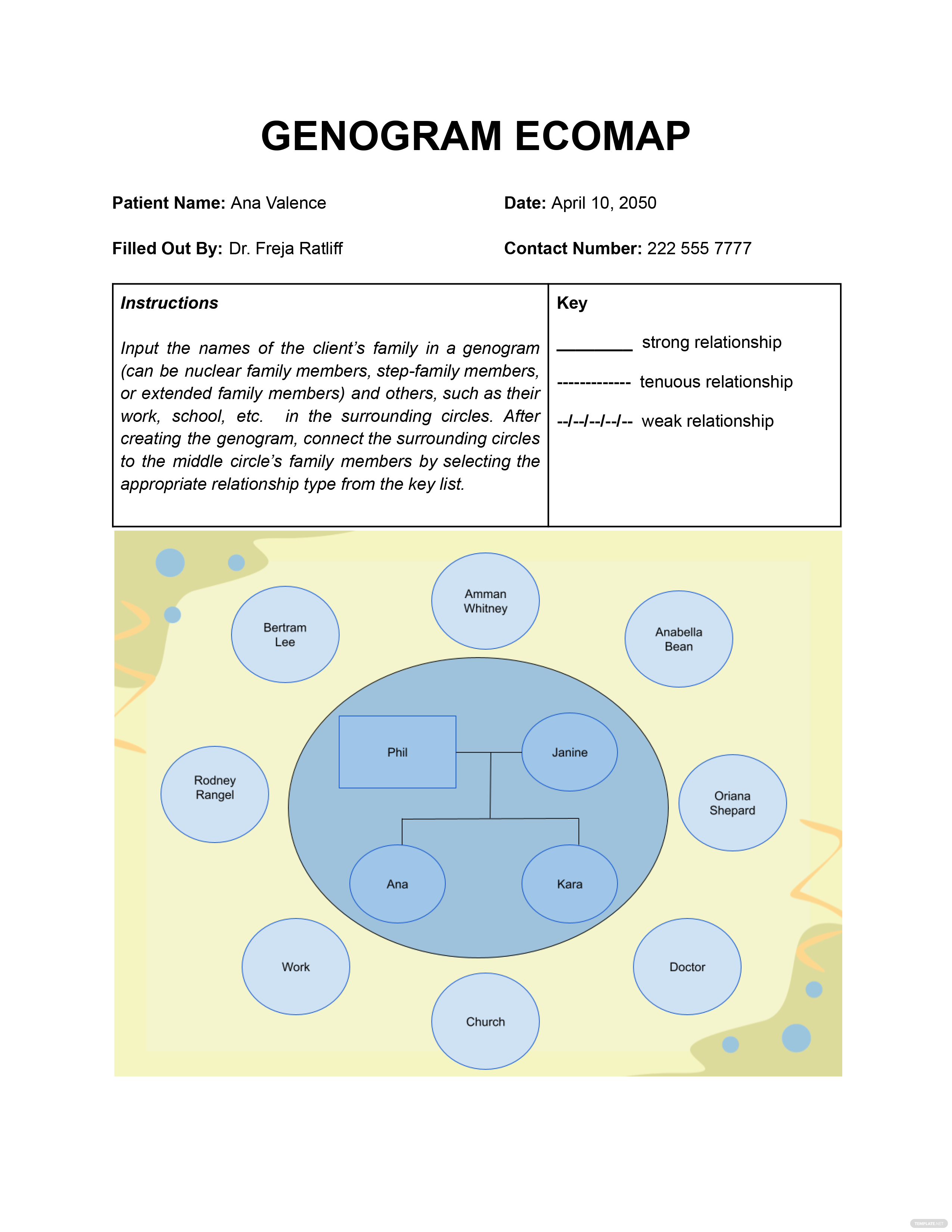
Family Ecomap
One popular type of an ecomap is the family ecomap. This graphic tool is more nuanced compared to a family tree because not only will you identify the names of family members but also their relationships and how different aspects go into a family’s life. A family ecomap is often used as a graphic design for family assessments concerning social work, adoption, or family therapy.
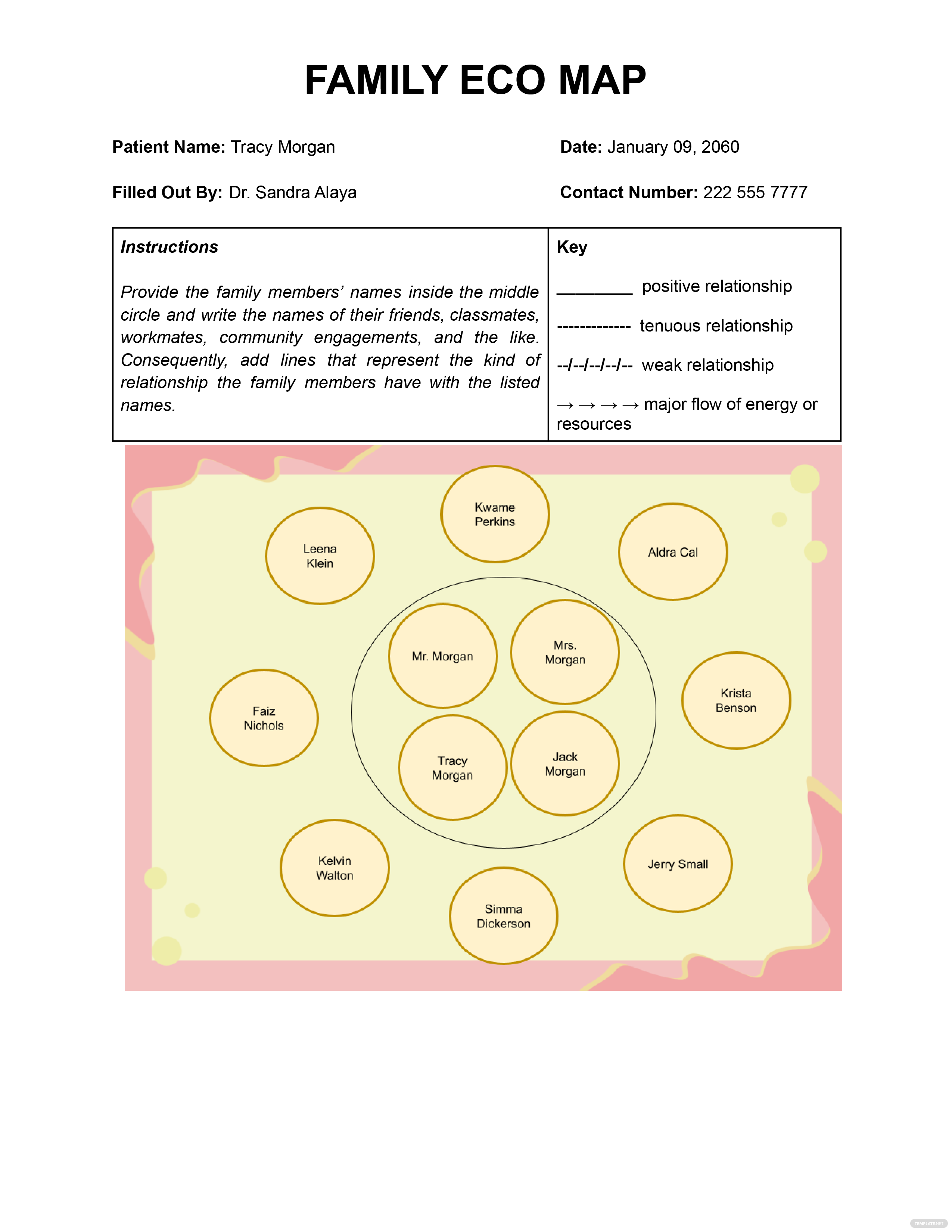
Social Work Ecomap
Social affinities and community rapports are essential when it comes to being socially healthy and there is a specific ecomap used by social workers for various purposes. Here enters the social work ecomap which outlines a client’s familial and social relationships such as to assess what could have been the issue of a person’s disconnection from other people. Social work ecomaps are more focused on the quality of a client’s relations.
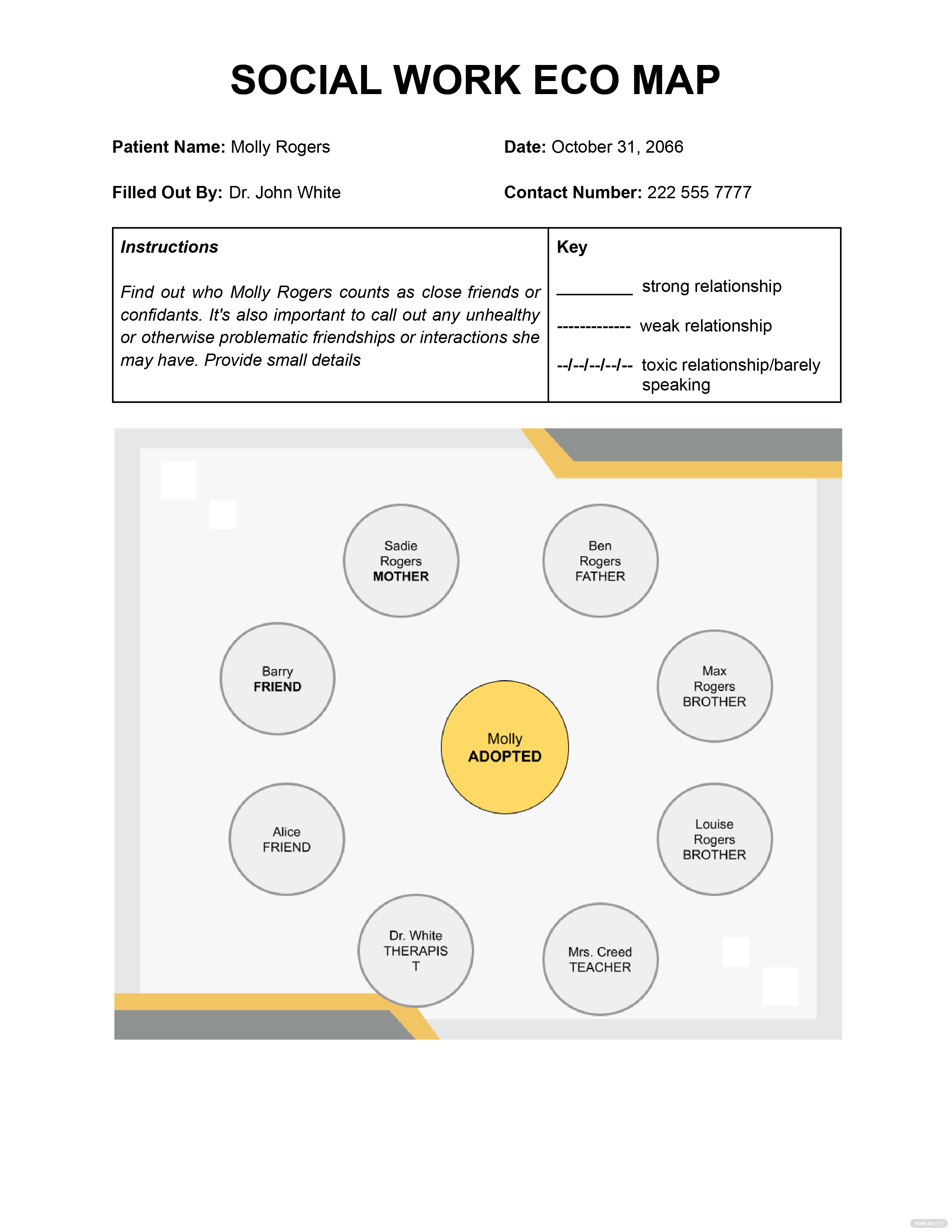
Individual Ecomap
One’s social relationship towards the environment and ecosystem is clearly expressed in an individual ecomap. From the name itself, you can tell that an individual ecomap maps out one person’s connections with others. A person can be influenced by one or a thousand connections and it would help to understand that specific person’s ecological perspective through an individual ecomap.
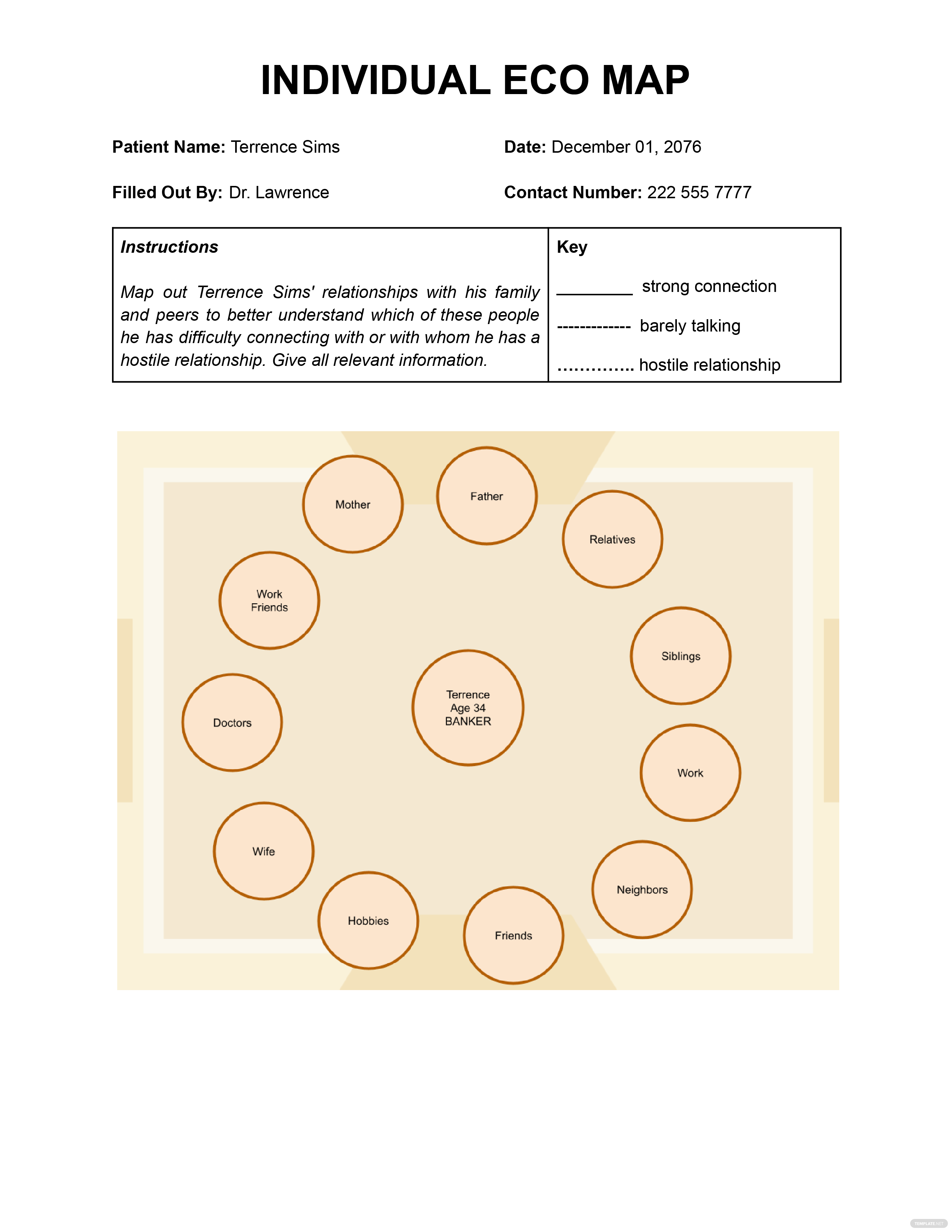
Nursing Ecomap
Nurses have their own intentions for using ecomaps and a nursing ecomap is the most fitting type of diagram for these health professionals. A nursing ecomap may structure where a patient’s persona could have been nurtured from, the connection of a person’s medical history, how functional health patterns are linked, etc. Social network connections gathered from nursing ecomaps would even be helpful for health research.
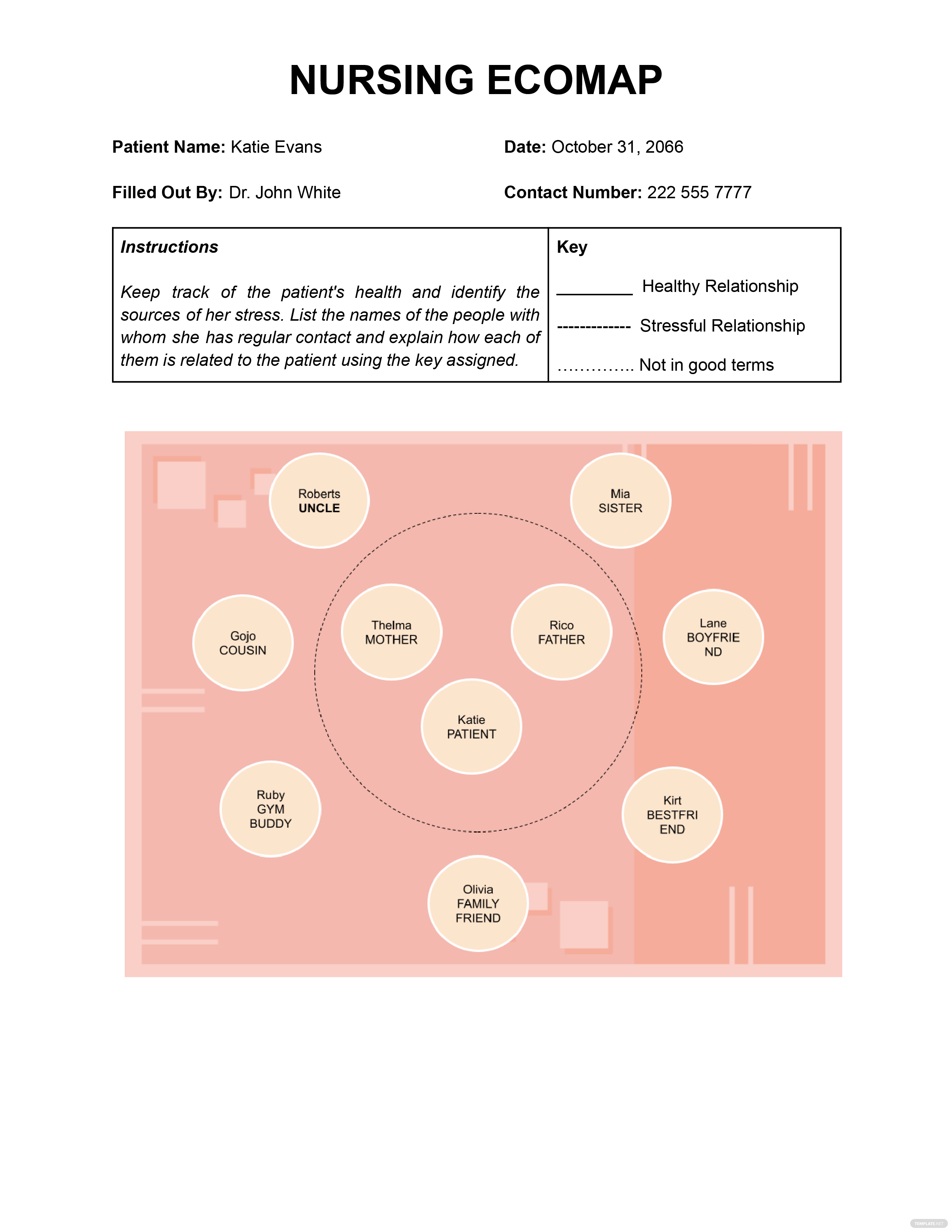
Personal Ecomap
Personal relationships of an individual to the rest of the environment are expressed in a graphic personal ecomap. An individual’s persona can be tracked according to one’s linked connections on a social and personal level. Thus, a personal ecomap is one of the many visual platforms you can use for profiling relations and comprehending how they are connected to each other.
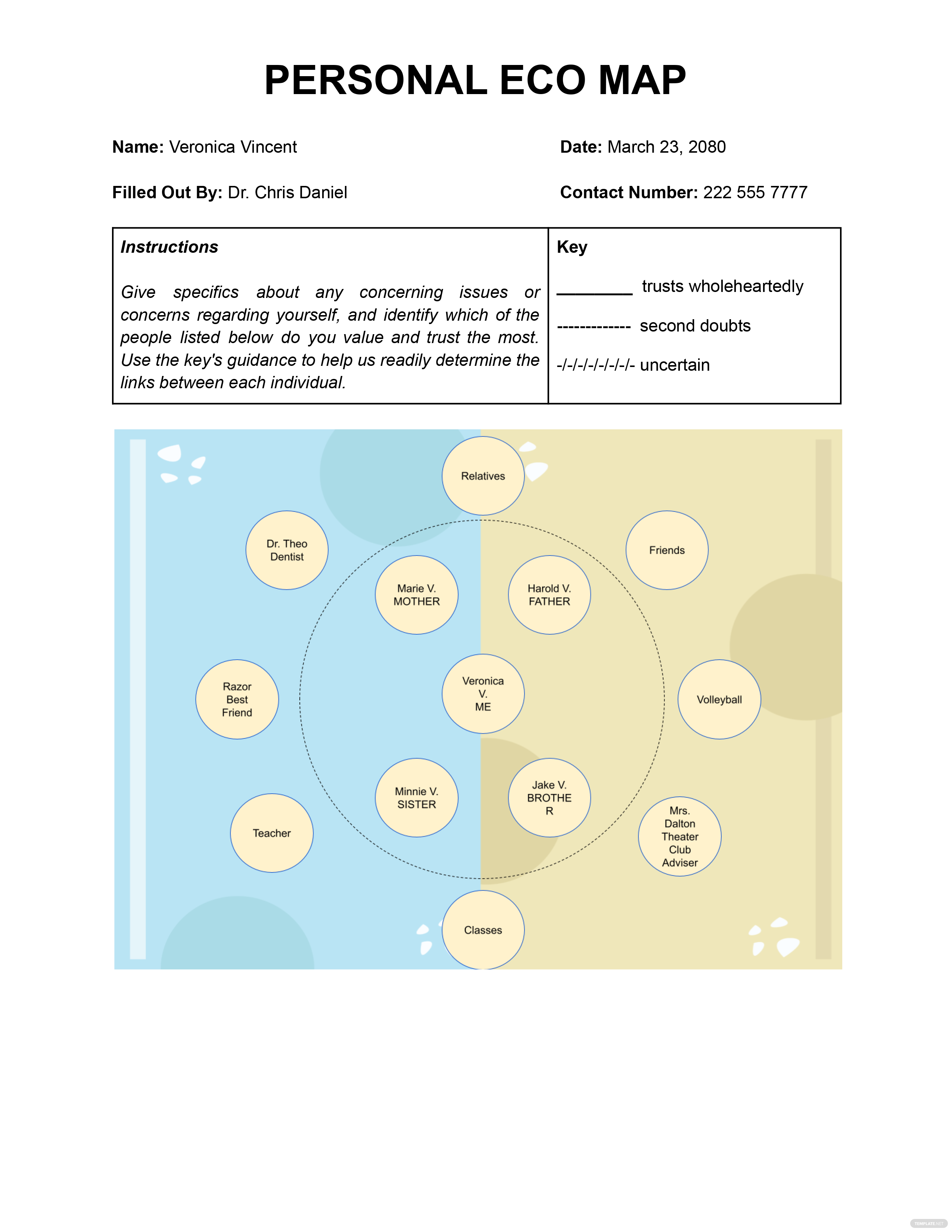
Blank Ecomap
A blank ecomap is basically a standard ecomap that you can fill out and sign. It is an editable graphic map where you can manually label the parts of an ecomap by filling in the blanks. Whether you opt for writing answers in a printed ecomap or typing the elements in a PDF or digital ecomap, make sure you know your labels carefully to correct your ecomap’s details.
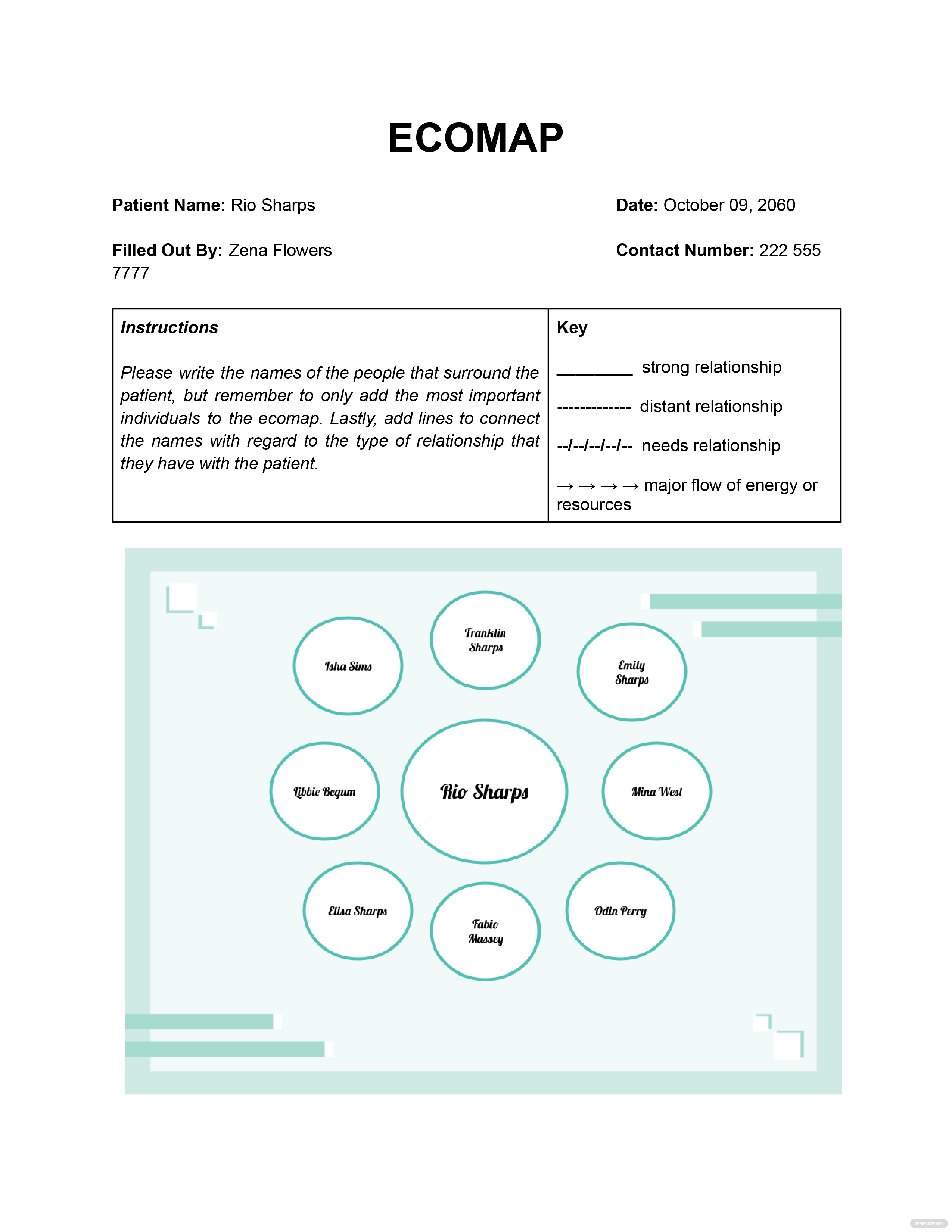
Community Ecomap
Community relationships, connections, and networks are properly displayed in a solid community ecomap. Use this specific ecomap to determine the different relationships in a community rather than including all sorts of external relations. How a person adjusts to a new community can be evaluated in this great example.
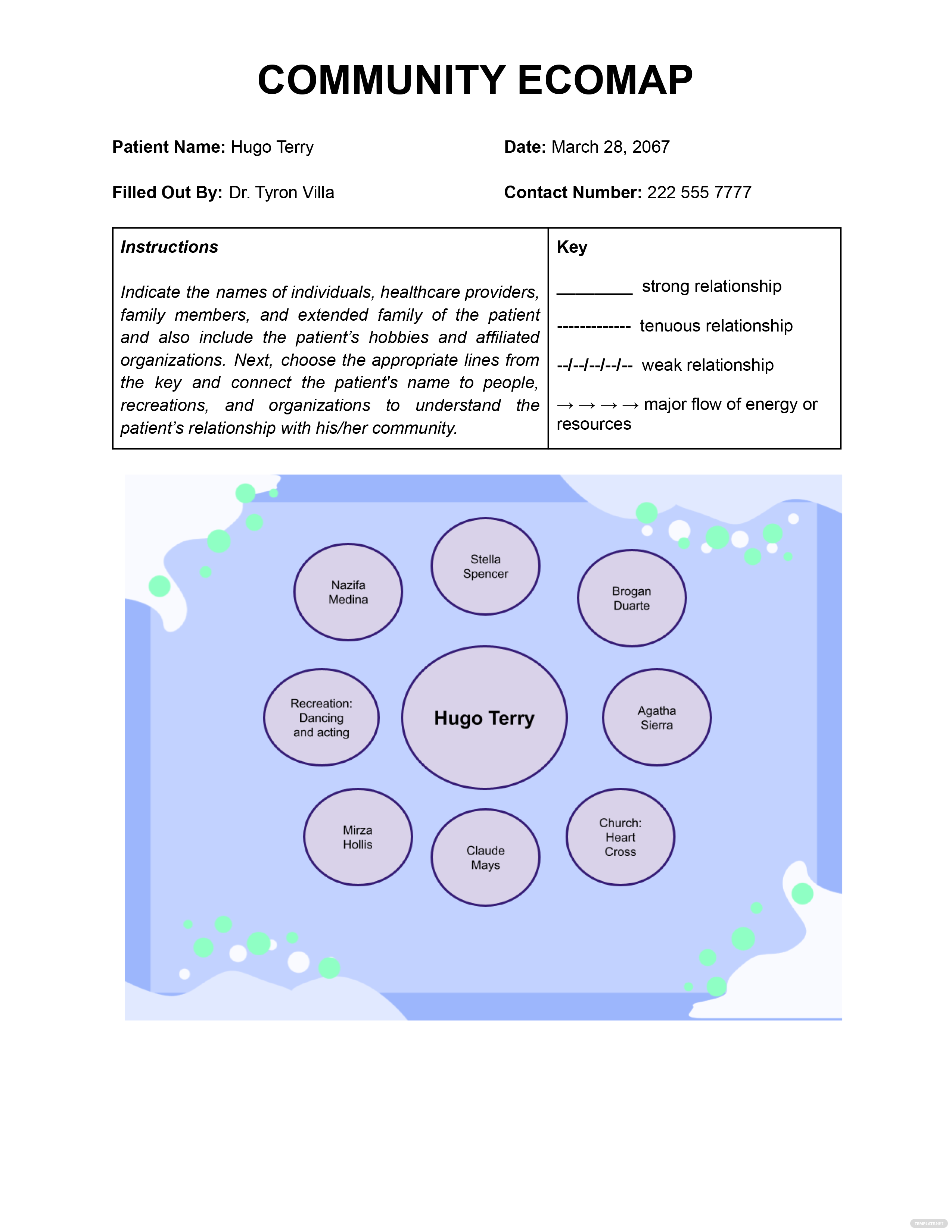
Organizational Ecomap
When the connections involved in a company or organization are the main concern of an assessment, be sure to utilize an organizational ecomap instead. A common checklist for you to include in an organizational ecomap is to evaluate the manager’s connections with the executive assistant, software development team, technology supply department, employees, building budget department, online marketing team, and customers. It depends on who the main subject of concern is as long as the relations displayed in the organizational ecomap are part of an organization.

One Person Ecomap
The one person ecomap outlines a single person’s relationship to any other individual she/he/they connected with. An example is during a counseling assessment where one’s psychology can be traced from who a client has contacted frequently before. Or perhaps, you refer to this ecomap when you need to gather evidence about a client’s connections, learn from who a person spends time and activity mostly, and more.
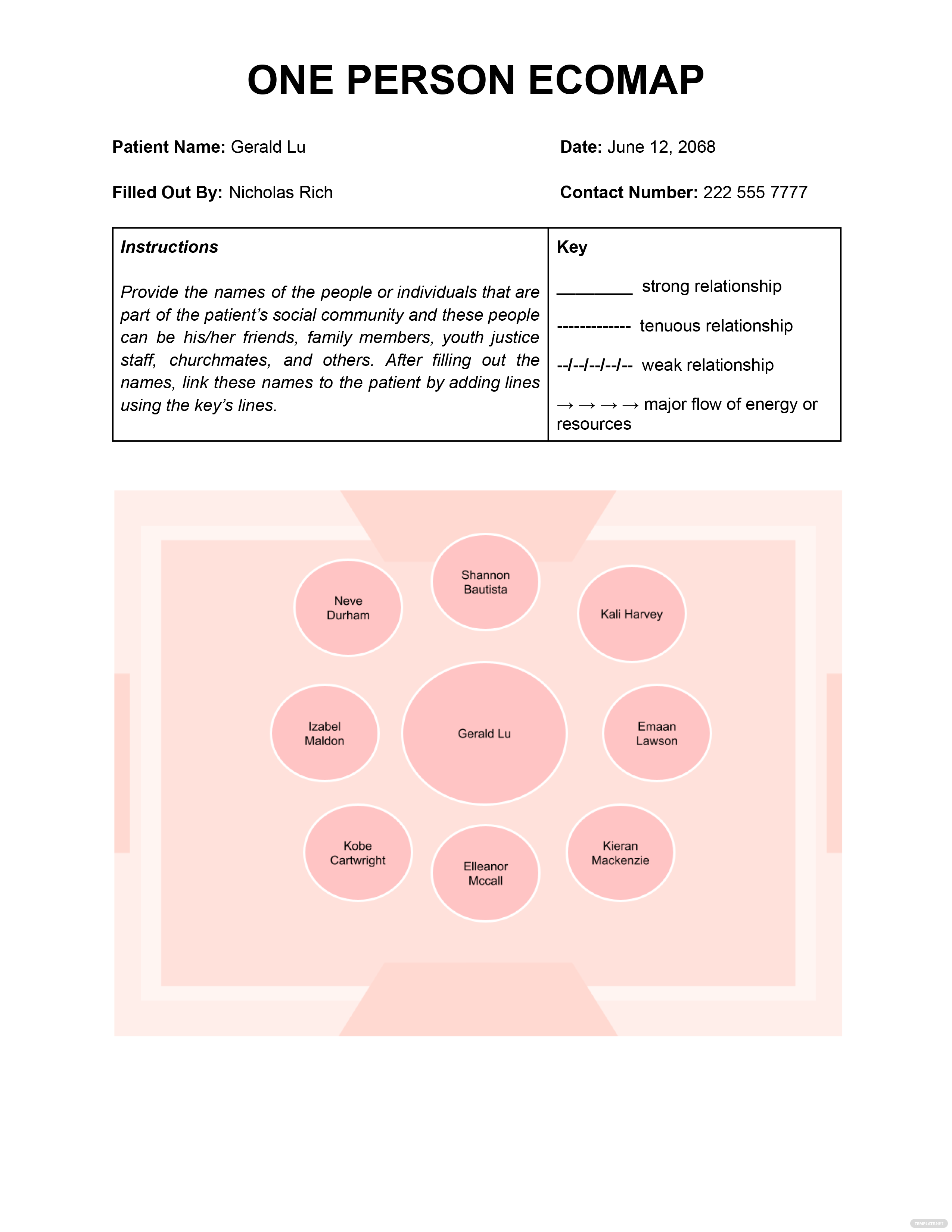
Ecomap Uses, Purpose, Importance
Ecomaps effectively portray an individual’s social connections but you might be wondering why it is necessary or important to do so. Rest assured, visual tools such as ecomaps play a significant role in society, such as the following:
Uses Schematic Visuals
An ecomap is an easy-to-read diagram about social connections consisting of a few words, circles, lines, and other shapes rather than using long paragraphs or articles to explain relations. With its schematic graphic presentation, you get the big picture as to where a person gets support from or which relationship could have brought conflict to a client. That said, it wholly depends on how detailed and coherent your data is in the ecomap.
Displays Connections between Parties
The ecomap’s special factor is it does more than being a profile of names linked to one subject of concern; it shows how each party is connected to one another. For example, you draw a set of broken lines between two names to depict a shaky connection while you draw a solid line for a strong relationship. It is through the custom symbols and easy-to-follow format of an ecomap that you visually understand how relationships work.
Assesses a Number of Ecological Aspects
A single ecomap could help explain a number of ecological assessments such as social needs, resources, strengths, weaknesses, and more. Remember that one client’s social environment may involve their links to school, work, child care, church, welfare support, and many other external factors. Ecomapping’s structured data can form a number of insights about the crucial networks of a subject.
Involves a Variety of Benefits
Don’t underestimate an ecomap’s benefits to society because there are quite a lot. Examples of benefits include how an ecomap can track the respondents’ network background of a social study, streamline the answers to questions in social work services, or identify the social context to a range of connections. Most importantly, leverage an ecomap to grab the context of every connection’s impact on the subject being evaluated.
Depicts the Systems Theory
You already know that social work assessments and ecomaps go hand in hand, and it actually has something to do with how ecomaps express the systems theory. The systems theory refers to a detailed study of systems, such as the artificial and natural interrelated components that affect various systems, but in an ecomap’s case, it is the system of relations. One can greatly evaluate a subject’s social connections to understand the quality of every relationship, the level of affinity, the nature of the connection, and more.
What’s in an Ecomap? Parts?
Title or Purpose
A title or purpose statement is where you indicate the type of ecomap you are portraying. Whether it is a social work ecomap, nursing ecomap, or any ecomap type, label your title accordingly so it won’t get mixed up with other types.
Main Circle
The main circle is found at the centermost portion of your ecomap design. This refers to the main individual or subject of concern, meaning this refers to the subject being evaluated in an ecomap.
Sub-Circles
The sub-circles are whom the main subject is connected with. Each sub-circle has its own label that depends on who is connected to the subject of concern, such as having one sub-circle for a family member, another sub-circle for a school contact, and more.
Connection Lines
The connection lines are found between the set of circles in the ecomap. They display what kind of relationship each linked networks are such as having a solid line to suggest a strong relationship, a broken line to display a weak connection, and a zigzag line to explain a stressful relationship.
Legend
The legend explains what each symbol or shape means in your ecomap. This is the part where you clarify what the main circle means, what the subcircles are, what every shape of a connection line means, and other additional visuals found there that need context.
How to Design an Ecomap
1. Decide the most opportune Ecomap Size
2. Identify the purpose of crafting an ecomap
3. Customize an Ecomap Template
4. Add the basic parts of an ecomap
5. Apply an easy-to-use format, layout, or design
6. Save your work and print or publish it
Ecomap vs. Genogram
An ecomap visually portrays personal affinities or social relationships from an ecological perspective.
A genogram refers to a graphic diagram that portrays the structure or composition of a family or organization.
What’s the Difference between an Ecomap, Flowchart, and Family Tree?
The ecomap is a staple visual tool for identifying relationships and explaining a subject’s personal or social rapport.
A flowchart is a graphic diagram that depicts a sequence or movement such as how a process works from start to end.
The family tree is a graphic design that shows the relationship between family members where the very root of the family tree refers to you or the subject of concern and the branches explain the rest of the family members.
Ecomap Sizes
You can insert an ecomap to an evaluation report, news article, PowerPoint presentation, business document, or any other file, and you have the leeway to decide what specific dimensions you want to use for your graphic design. In case you need help deciding the right ecomap sizes for future projects, you can always refer to the standard document sizes for these in either portrait or landscape orientation.
Format | Inches | Millimeters |
| Letter Ecomap | 8.5” x 11” | 215.9mm x 279.4mm |
| Legal Ecomap | 8.5” x 14” | 216mm x 356mm |
| A4 Ecomap | 8.3” x 11.7” | 210mm x 297mm |
| Tabloid Ecomap | 11” x 17” | 279.4mm x 431.8mm |
Ecomap Ideas & Examples
No single ecomap works for all functions because you can’t simply use the same labels and categories from a spiritual ecomap to a nursing ecomap. The key is to identify your ecomap’s purpose and eventually tailor its content according to the right ecomap ideas and examples that work on your application.
- Ecomap For Adoption Ideas and Examples
- Basic Ecomap Ideas and Examples
- Sample Ecomap Ideas and Examples
- Agency Ecomap Ideas and Examples
- Spiritual Ecomap Ideas and Examples
- Simple Ecomap Ideas and Examples
- Social Work Ecomap Ideas and Examples
- Nursing Ecomap Ideas and Examples
- Family Ecomap Ideas and Examples
- Organizational Ecomap Ideas and Examples
FAQs
What should be included in an ecomap?
General ecomaps include connections to extended family members, school, friends, church, social services, medical services, sports teams, workmates, social clubs, and communities.
What do the symbols of an ecomap mean?
A thick line refers to a strong relationship, a dotted or broken line means a weak relationship, and a zigzag line means a stressed relationship.
How do you describe an ecomap?
An ecomap is a like a concept map except it graphically portrays a person’s connections and relationships rather than ideas.
What is an ecomap in education?
An ecomap can be used for educational purposes such as determining the different relationships and aspects of a person’s life in a visual way.
Who developed eco maps?
It was developed by Ann Hartman.
What are the arrows for in an ecomap?
Ecomap arrows pinpoint which direction a specific energy or flow goes from one connection to another.
How do you read an ecomap?
Simply understand the legend of each symbol or shape in an ecomap and it would be easy to navigate or comprehend the whole data there.
Why are ecomaps specific to social work?
Ecomaps help social work services identify which assistance clients need or where they got particular influences from, as depicted in the relationships displayed in an ecomap.
What is a community ecomap?
A community ecomap tackles a subject of concern’s set of relationships and connections within a community.
What do ecomaps do?
Ecomaps basically outline the series of networks a person or entity has as well as how the subject is linked to each connection.

